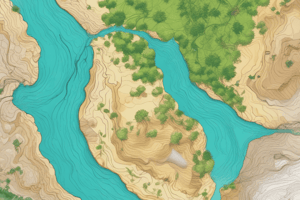Podcast
Questions and Answers
What are the four dimensions of a stream?
What are the four dimensions of a stream?
- Length, Width, Depth, and Time (correct)
- Erosion, Transportation, Deposition, and Capacity
- Length, Profile, Sediment, and Vegetation
- Gradient, Profile, Velocity, and Time
Which type of stream morphology is characterized by a meandering path commonly found in the floodplain depositional zone?
Which type of stream morphology is characterized by a meandering path commonly found in the floodplain depositional zone?
- Anabranched Channel
- Braided Channel
- Straight Channel
- Meandering Channel (correct)
Which of the following best describes alluvial channels?
Which of the following best describes alluvial channels?
- Channels primarily characterized by deep rocky structures
- Channels formed in and by sediment transported by the river (correct)
- Channels that are steady and unchanging
- Channels that are permanently fixed by man-made structures
What is the significance of hyporheic flow in relation to stream dimensions?
What is the significance of hyporheic flow in relation to stream dimensions?
Which characteristic is NOT typical of a youthful stream?
Which characteristic is NOT typical of a youthful stream?
What type of erosion occurs in the upper reaches of a stream?
What type of erosion occurs in the upper reaches of a stream?
What feature is formed from the ancient floodplain under different climate conditions?
What feature is formed from the ancient floodplain under different climate conditions?
What type of valleys are typically found in the lower reaches of a stream?
What type of valleys are typically found in the lower reaches of a stream?
What term describes the level at which no further erosion can occur?
What term describes the level at which no further erosion can occur?
What is created where a mountain river meets a flat valley or plain?
What is created where a mountain river meets a flat valley or plain?
Flashcards are hidden until you start studying
Study Notes
4-Dimensions of Streams
- Longitudinal Dimension: Measures the length of the stream.
- Lateral Dimension: Refers to the width of the floodplain.
- Vertical Dimension: Includes stream depth and hyporheic zones, where approximately 30% of river flow occurs underground via downwelling and upwelling.
- Time Dimension: Encompasses daily, seasonal, and annual variations in stream dynamics.
Stream Morphology
- Profiles: Characterized by slope and gradient from headwaters to base level.
- Patterns: Observations include:
- Meandering: Common in floodplains, characterized by lateral movement.
- Straight: Often unnatural, created by human interventions.
- Braided: Common near glaciers with high sediment loads and minimal vegetation.
- Anabranched: Complex systems with larger braids and vegetated islands.
Channel Types
- Alluvial Channels: Formed and modified by sediment transported by the river; highly dynamic.
- Non-Alluvial Channels: Maintained by bedrock or concrete, characterized by deep cuts into deposits.
Stream Profile
- Upper Reaches:
- Features vertical erosion leading to V-shaped valleys.
- Steep gradients with the presence of rapids, waterfalls, and lag boulders.
- Lower Reaches:
- Involves lateral erosion resulting in U-shaped valleys.
- Characterized by gentle gradients with terraces, floodplains, meanders, and point bars.
Base Level
- Defined as the level beyond which erosion ceases, significant in understanding river dynamics.
- Alluvial Fans and Deltas:
- Formed at points where rivers meet level ground, creating distinct sediment deposits.
Fluvial Processes
- Erosion:
- Removes weathered materials through physical (scouring, cavitation) and chemical processes (dissolution of minerals).
- Transportation:
- Movement of materials categorized as bedload (saltation, traction), suspended load (turbidity), and dissolved load (conductivity).
- Deposition:
- Occurs as the stream slows, depositing alluvium and forming floodplains, levees, and alluvial fans.
Fluvial Determinants
- Key Variables: Velocity, discharge, and turbulence determine a stream's capacity to carry sediment.
- Capacity: Maximum total load a stream can transport.
- Competence: Ability to move particles of specific sizes, indicated by D-95 and D-50, which measure particle size distribution.
Particle Size Classification
- Varies from boulders (>256 mm) to silt (<0.063 mm), with size generally decreasing downstream from rocky headwaters to sandy lowland rivers.
Studying That Suits You
Use AI to generate personalized quizzes and flashcards to suit your learning preferences.




